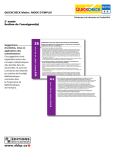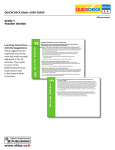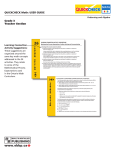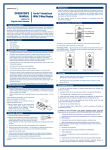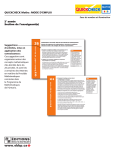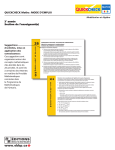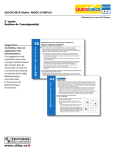Transcript
Quickcheck Math: user guide Data Management and Probability Grade 2 Teacher Section Learning Connection Activity Suggestions: These suggestions are organized around the same key math concepts addressed in the 24 activities. They relate to some of the Mathematical Process Expectations used in the Ontario Math Curriculum. 26 T e a c h e r S e c T i o n leaRning connection activity sUggestions Mathematical Process expectations: Reasoning and Proving, connecting, Representing n sort and classify objects using two attributes simultaneously. Put on a piece of music that all your students know. In small groups of 4 to 5 students, have your students determine a way to mark the beat by clapping, patting, snapping, blinking, etc. Stop the music. Now ask your students to sort themselves by boy or girl and by the action they used to mark the beat and then play the piece a second time. Finally, have students regroup themselves into boy or girl, same hair colour and the common way they mark the beat. Play the piece a third time? “What was the difference between the size of the groups the second time the music was played and the third time? What is the reason for this change?” n Read data presented in pictographs, bar graphs, line plots and other graphic organizers. As a class, brainstorm questions that are of interest to the whole group and that can be easily answered by the students in only a few different ways, such as their favourite season, favourite things to do at recess, the season with the most student birthdays in the class, etc. Once a question has been chosen, have a small group determine a selection of probable answers and survey classmates, tracking the responses using a tally chart. The rest of the students will be divided into groups of four and will be responsible for representing the data collected by the first group in a designated graphing format: line plot, simple bar graph, pictograph or diagram. Make sure that the groups give their graphs a title and that the x- and y-axes are labelled appropriately. and numbers n distinguish between numbers that represent data values 11-08-01 11:07 that represent the frequency of an event. 2m74-EN.indd 51 T e a c h e r S e c T i o n 2m74-EN.indd 52 For one month, have your class monitor the daily forecasted temperature highs. To do this, try using your local weather station’s website or your newspaper. The temperatures can be recorded on a clip board, class calendar or spreadsheet. Once the data is complete, plot the data values (range of temperatures) on the x axis using horizontal chart paper. Then plot the frequency of occurrence of each temperature using a line plot format. Ask students to find the data values (temperatures) that occurred most often that month. Now ask a question about frequency of occurrence: “How many days did we record that temperature this month?” n demonstrate understanding of data presented in graphs by comparing parts of the data with the whole. Using the data represented in one of the graphs above, have students on their own or with a partner write three comparative statements about parts of the data as they relate to each other or as they relate to the whole. Using number sentences or open number lines, have them prove or disprove each of their statements. 11-08-01 11:07
